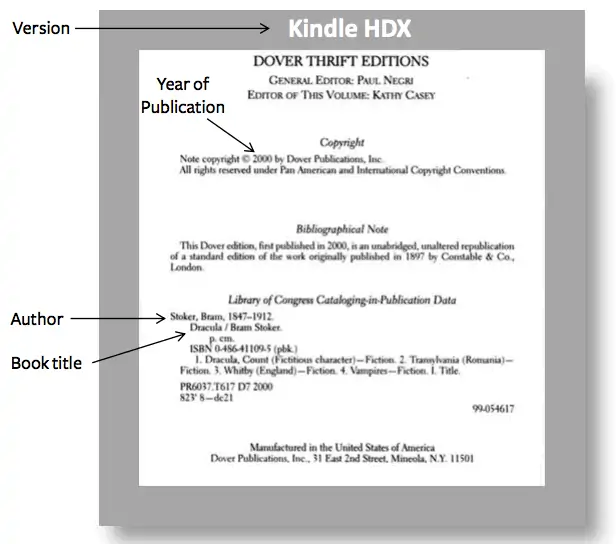How to Cite an E-book in Chicago
Published July 30, 2014. Updated August 8, 2022.
Given the prevalence of e-books and the devices and platforms used to access them, it is likely that you may need to cite an e-book when completing a paper or project. Chicago style guidelines indicate that citations should specify if the book was consulted in an e-book format because of the potential for differences between versions. Besides adding information about the e-book’s format, e-book citations are very similar to print books citations in Chicago style. This guide will show you how to cite an e-book in notes-bibliography style using the 17th edition of the Chicago Manual of Style.
Guide Overview
- Citing an e-book from an e-reader
- Citing an e-book accessed online
- Citing an e-book found in a database
- Citing an e-book on CD-ROM
- Citing an e-book with no page numbers
- What you need
Citing an E-Book from an E-Reader (Kindle, iPad, Nook, etc.)
Citation Structure:
Note:
1. First name Last name, Book Title (City: Publisher, year published), page or location number, E-Reader name.
Bibliography:
Last name, First name. Book Title. City: Publisher, year published. E-Reader name.

Citation Example:
Note:
1. Bram Stoker, Dracula (Mineola, NY: Dover Publications, 2000), 25, Kindle.
Bibliography:
Stoker, Bram. Dracula. Mineola, NY: Dover Publications, 2000. Kindle.
Citing an E-Book Accessed Online
Citation Structure:
Note:
1. First name Last name, Book Title (City: Publisher, year published), page or location number, URL.
Bibliography:
Last name, First name. Book Title. City: Publisher, year published. URL.
Citation Example:
Note:
1. Carol J. Clover, The Medieval Saga (Ithaca, NY: Cornell University Press, 1982), 19, https://www.jstor.org/stable/10.7591/j.ctvn1t9s7.
Bibliography:
Clover, Carol J. The Medieval Saga. Ithaca, NY: Cornell University Press, 1982. https://www.jstor.org/stable/10.7591/j.ctvn1t9s7.
Citing an E-Book Found in a Database
If you access an e-book via a commercial or institutional database for which a URL is not available or would not be accessible for your reader, you should include the name of the database instead of a URL.
Citation Structure:
Note:
1. First name Last name, Book Title (City: Publisher, year published), page or location number, Database Name.
Bibliography:
Last name, First name. Book Title. City: Publisher, year published. Database Name.
Citation Example:
Note:
1. John Stolle-McAllister, Intercultural Interventions: Politics, Community, and Environment in the Otavalo Valley (Amherst, NY: Cambria Press, 2019), MD-SOAR.
Bibliography:
Stolle-McAllister, John. Intercultural Interventions: Politics, Community, and Environment in the Otavalo Valley. Amherst, NY: Cambria Press, 2019. MD-SOAR.
Note: Some e-books may be available online through your library’s databases or catalogs.
Citing an E-Book on CD-ROM
While it is no longer common to access e-books via CD-ROM, some textbooks or other similar books come with CD versions that you may need to cite. In such cases, the format should be placed at the end of the citation instead of the URL/database name/e-reader name.
Citation Structure:
Note:
1. First name Last name, Book Title (City: Publisher, year published), page or location number, CD-ROM.
Bibliography:
Last name, First name. Book Title. City: Publisher, year published. CD-ROM.
Citation Example:
Note:
1. Ana C. Jarvis, Basic Spanish, Spanish ed. (Boston: Houghton Mifflin College Division, 2007), chap. 1, CD-ROM.
Bibliography:
Jarvis, Ana C. Basic Spanish. Spanish ed. Boston: Houghton Mifflin College Division, 2007. CD-ROM.
Citing an E-Book with No Page Numbers
When citing e-books in Chicago style (especially e-book versions of older books), it is preferable to use a version with scanned pages in order to be able to use the original page numbers. However, such versions may not be available. If you are citing an e-book that does not have page numbers, you should use whatever location information is available in place of the page number in a note. For example, you can use the chapter number or section heading of the passage you are citing.
The Chicago Manual of Style advises against using location indicators from your e-reader device in place of page numbers, as these may change based on text size and other settings set by individual readers. If an e-reader location indicator must be used, you should also include the total number of locations to help your readers find the cited passage on their own device. (For example, “loc. 45 of 1028.”)
Citation Structure:
Note:
1. First name Last name, Book Title (City: Publisher, year published), chapter number or section heading, format or URL.
Bibliography:
Last name, First name. Book Title. City: Publisher, year published. Format or URL.
Citation Example:
Note:
1. Ernest Hemingway, The Sun Also Rises (New York: Charles Scribner’s Sons, 1926), chap. 2, https://www.gutenberg.org/files/67138/67138-h/67138-h.htm.
Bibliography:
Hemingway, Ernest. The Sun Also Rises. New York: Charles Scribner’s Sons, 1926. https://www.gutenberg.org/files/67138/67138-h/67138-h.htm.
What You Need
A citation for an e-book usually includes the following:
- Author name
- Book title
- Edition information (if applicable)
- Publisher city
- Publisher name
- Publication year
- Page number or location information (in note only)
- E-reader name, database name, format, or URL
